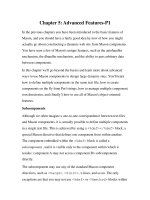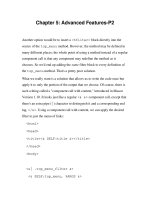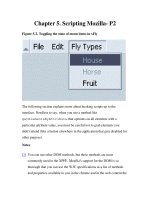Chapter 5 memory hierarchy
Bạn đang xem bản rút gọn của tài liệu. Xem và tải ngay bản đầy đủ của tài liệu tại đây (1.94 MB, 95 trang )
Computer Architecture
Chapter 5: Memory Hierarchy
Dr. Phạm Quốc Cường
Adapted from Computer Organization the Hardware/Software Interface – 5th
Computer Engineering – CSE – HCMUT
1
Principle of Locality
• Programs access a small proportion of their
address space at any time
• Temporal locality
– Items accessed recently are likely to be accessed again
soon
– e.g., instructions in a loop, induction variables
• Spatial locality
– Items near those accessed recently are likely to be
accessed soon
– E.g., sequential instruction access, array data
Chapter 5 — Memory Hierarchy
2
Taking Advantage of Locality
• Memory hierarchy
• Store everything on disk
• Copy recently accessed (and nearby) items
from disk to smaller DRAM memory
– Main memory
• Copy more recently accessed (and nearby)
items from DRAM to smaller SRAM memory
– Cache memory attached to CPU
Chapter 5 — Memory Hierarchy
3
Memory Hierarchy Levels
• Block (aka line): unit of
copying
– May be multiple words
• If accessed data is present in
upper level
– Hit: access satisfied by upper
level
• Hit ratio: hits/accesses
• If accessed data is absent
– Miss: block copied from lower
level
• Time taken: miss penalty
• Miss ratio: misses/accesses
= 1 – hit ratio
– Then accessed data supplied
from upper level
Chapter 5 — Memory Hierarchy
4
Memory Technology
• Static RAM (SRAM)
– 0.5ns – 2.5ns, $2000 – $5000 per GB
• Dynamic RAM (DRAM)
– 50ns – 70ns, $20 – $75 per GB
• Flash Memory
– 5s – 50s, $0.75 - $1 per GB
• Magnetic disk
– 5ms – 20ms, $0.20 – $2 per GB
• Ideal memory
– Access time of SRAM
– Capacity and cost/GB of disk
Chapter 5 — Memory Hierarchy
5
Cache Memory
• Cache memory
– The level of the Mem. hierarchy closest to the CPU
• Given accesses X1, …, Xn–1, Xn
• How do we know if
the data is present?
• Where do we look?
Chapter 5 — Memory Hierarchy
6
Direct Mapped Cache
• Location determined by address
• Direct mapped: only one choice
– (Block address) modulo (#Blocks in cache)
• #Blocks is a
power of 2
• Use low-order
address bits
Chapter 5 — Memory Hierarchy
7
Tags and Valid Bits
• How do we know which particular block is
stored in a cache location?
– Store block address as well as the data
– Actually, only need the high-order bits
– Called the tag
• What if there is no data in a location?
– Valid bit: 1 = present, 0 = not present
– Initially 0
Chapter 5 — Memory Hierarchy
8
Cache Example
• 8-blocks, 1 word/block, direct mapped
• Initial state
Index
V
000
N
001
N
010
N
011
N
100
N
101
N
110
N
111
N
Tag
Data
Chapter 5 — Memory Hierarchy
9
Cache Example
Word addr
Binary addr
Hit/miss
Cache block
22
10 110
Miss
110
Index
V
000
N
001
N
010
N
011
N
100
N
101
N
110
Y
111
N
Tag
Data
10
Mem[10110]
Chapter 5 — Memory Hierarchy
10
Cache Example
Word addr
Binary addr
Hit/miss
Cache block
26
11 010
Miss
010
Index
V
000
N
001
N
010
Y
011
N
100
N
101
N
110
Y
111
N
Tag
Data
11
Mem[11010]
10
Mem[10110]
Chapter 5 — Memory Hierarchy
11
Cache Example
Word addr
Binary addr
Hit/miss
Cache block
22
10 110
Hit
110
26
11 010
Hit
010
Index
V
000
N
001
N
010
Y
011
N
100
N
101
N
110
Y
111
N
Tag
Data
11
Mem[11010]
10
Mem[10110]
Chapter 5 — Memory Hierarchy
12
Cache Example
Word addr
Binary addr
Hit/miss
Cache block
16
10 000
Miss
000
3
00 011
Miss
011
16
10 000
Hit
000
Index
V
Tag
Data
000
Y
10
Mem[10000]
001
N
010
Y
11
Mem[11010]
011
Y
00
Mem[00011]
100
N
101
N
110
Y
10
Mem[10110]
111
N
Chapter 5 — Memory Hierarchy
13
Cache Example
Word addr
Binary addr
Hit/miss
Cache block
18
10 010
Miss
010
Index
V
Tag
Data
000
Y
10
Mem[10000]
001
N
010
Y
10
Mem[10010]
011
Y
00
Mem[00011]
100
N
101
N
110
Y
10
Mem[10110]
111
N
Chapter 5 — Memory Hierarchy
14
Address Subdivision
Chapter 5 — Memory Hierarchy
15
Example: Larger Block Size
• 64 blocks, 16 bytes/block
– To what block number does address 1200 map?
• Block address = 1200/16 = 75
• Block number = 75 modulo 64 = 11
31
10 9
4 3
0
Tag
Index
Offset
22 bits
6 bits
4 bits
Chapter 5 — Memory Hierarchy
16
Block Size Considerations
• Larger blocks should reduce miss rate
– Due to spatial locality
• But in a fixed-sized cache
– Larger blocks fewer of them
• More competition increased miss rate
– Larger blocks pollution
• Larger miss penalty
– Can override benefit of reduced miss rate
– Early restart and critical-word-first can help
Chapter 5 — Memory Hierarchy
17
Cache Misses
• On cache hit, CPU proceeds normally
• On cache miss
– Stall the CPU pipeline
– Fetch block from next level of hierarchy
– Instruction cache miss
• Restart instruction fetch
– Data cache miss
• Complete data access
Chapter 5 — Memory Hierarchy
18
Write-Through
• On data-write hit, could just update the block in
cache
– But then cache and memory would be inconsistent
• Write through: also update memory
• But makes writes take longer
– e.g., if base CPI = 1, 10% of instructions are stores, write to
memory takes 100 cycles
ã Effective CPI = 1 + 0.1ì100 = 11
• Solution: write buffer
– Holds data waiting to be written to memory
– CPU continues immediately
• Only stalls on write if write buffer is already full
Chapter 5 — Memory Hierarchy
19
Write-Back
• Alternative: On data-write hit, just update the
block in cache
– Keep track of whether each block is dirty
• When a dirty block is replaced
– Write it back to memory
– Can use a write buffer to allow replacing block to
be read first
Chapter 5 — Memory Hierarchy
20
Write Allocation
• What should happen on a write miss?
• Alternatives for write-through
– Allocate on miss: fetch the block
– Write around: don’t fetch the block
• Since programs often write a whole block before
reading it (e.g., initialization)
• For write-back
– Usually fetch the block
Chapter 5 — Memory Hierarchy
21
Example: Intrinsity FastMATH
• Embedded MIPS processor
– 12-stage pipeline
– Instruction and data access on each cycle
• Split cache: separate I-cache and D-cache
– Each 16KB: 256 blocks × 16 words/block
– D-cache: write-through or write-back
• SPEC2000 miss rates
– I-cache: 0.4%
– D-cache: 11.4%
– Weighted average: 3.2%
Chapter 5 — Memory Hierarchy
22
Example: Intrinsity FastMATH
Chapter 5 — Memory Hierarchy
23
Main Memory Supporting Caches
• Use DRAMs for main memory
– Fixed width (e.g., 1 word)
– Connected by fixed-width clocked bus
• Bus clock is typically slower than CPU clock
• Example cache block read
– 1 bus cycle for address transfer
– 15 bus cycles per DRAM access
– 1 bus cycle per data transfer
• For 4-word block, 1-word-wide DRAM
– Miss penalty = 1 + 4×15 + 4×1 = 65 bus cycles
– Bandwidth = 16 bytes / 65 cycles = 0.25 B/cycle
Chapter 5 — Memory Hierarchy
24
Increasing Memory Bandwidth
• 4-word wide memory
-
Miss penalty = 1 + 15 + 1 = 17 bus cycles
Bandwidth = 16 bytes / 17 cycles = 0.94 B/cycle
• 4-bank interleaved memory
-
Miss penalty = 1 + 15 + 4×1 = 20 bus cycles
Bandwidth = 16 bytes / 20 cycles = 0.8 B/cycle
Chapter 5 — Memory Hierarchy
25









